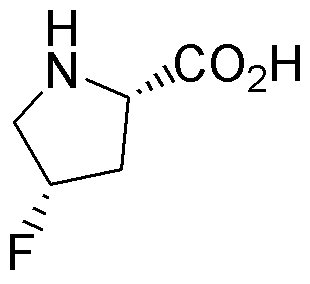cis-4-Fluoro-L-proline is widely utilized in research focused on:
- Pharmaceutical Development: This compound serves as a building block in the synthesis of novel drugs, particularly in the development of antiviral and anticancer agents, enhancing therapeutic efficacy.
- Peptide Synthesis: It is incorporated into peptides to modify their properties, improving stability and bioactivity, which is crucial in drug design and protein engineering.
- Neuroscience Research: Researchers use it to study neurotransmitter systems, as it can influence the activity of certain receptors, providing insights into neurological disorders.
- Biochemical Studies: Its unique fluorine atom allows for better tracking in metabolic studies, making it valuable in understanding metabolic pathways and enzyme functions.
- Material Science: The compound is explored for its potential in creating new materials with specific properties, such as enhanced mechanical strength or thermal stability.
General Information
Properties
Safety and Regulations
Applications
cis-4-Fluoro-L-proline is widely utilized in research focused on:
- Pharmaceutical Development: This compound serves as a building block in the synthesis of novel drugs, particularly in the development of antiviral and anticancer agents, enhancing therapeutic efficacy.
- Peptide Synthesis: It is incorporated into peptides to modify their properties, improving stability and bioactivity, which is crucial in drug design and protein engineering.
- Neuroscience Research: Researchers use it to study neurotransmitter systems, as it can influence the activity of certain receptors, providing insights into neurological disorders.
- Biochemical Studies: Its unique fluorine atom allows for better tracking in metabolic studies, making it valuable in understanding metabolic pathways and enzyme functions.
- Material Science: The compound is explored for its potential in creating new materials with specific properties, such as enhanced mechanical strength or thermal stability.
Documents
Safety Data Sheets (SDS)
The SDS provides comprehensive safety information on handling, storage, and disposal of the product.
Product Specification (PS)
The PS provides a comprehensive breakdown of the product’s properties, including chemical composition, physical state, purity, and storage requirements. It also details acceptable quality ranges and the product's intended applications.
Certificates of Analysis (COA)
Search for Certificates of Analysis (COA) by entering the products Lot Number. Lot and Batch Numbers can be found on a product’s label following the words ‘Lot’ or ‘Batch’.
Numéro de catalogue
Numéro de lot/série
Certificates Of Origin (COO)
This COO confirms the country where the product was manufactured, and also details the materials and components used in it and whether it is derived from natural, synthetic, or other specific sources. This certificate may be required for customs, trade, and regulatory compliance.
Numéro de catalogue
Numéro de lot/série
Safety Data Sheets (SDS)
The SDS provides comprehensive safety information on handling, storage, and disposal of the product.
DownloadProduct Specification (PS)
The PS provides a comprehensive breakdown of the product’s properties, including chemical composition, physical state, purity, and storage requirements. It also details acceptable quality ranges and the product's intended applications.
DownloadCertificates of Analysis (COA)
Search for Certificates of Analysis (COA) by entering the products Lot Number. Lot and Batch Numbers can be found on a product’s label following the words ‘Lot’ or ‘Batch’.
Numéro de catalogue
Numéro de lot/série
Certificates Of Origin (COO)
This COO confirms the country where the product was manufactured, and also details the materials and components used in it and whether it is derived from natural, synthetic, or other specific sources. This certificate may be required for customs, trade, and regulatory compliance.


